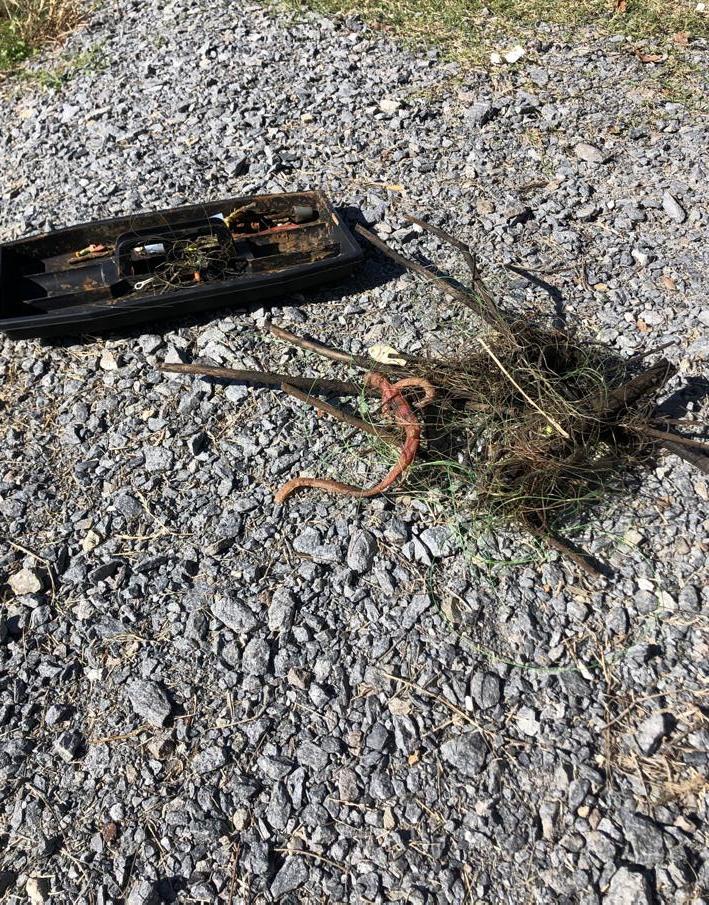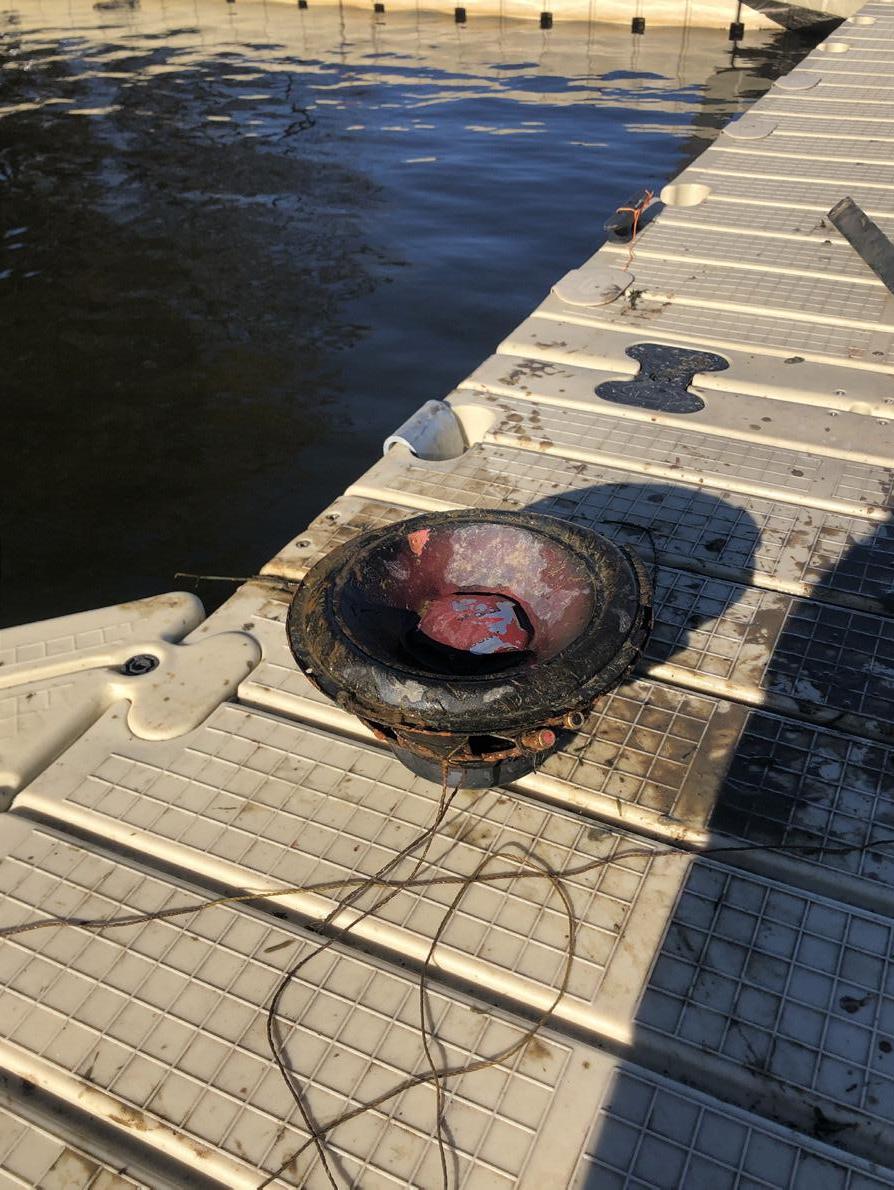
6 minute read
MAGNETIC FISHING
An EAST Project From Star City High School
The project’s goal is to remove metal and debris from our local state park lake, Cane Creek State Park and learn about the possible historical significance of items we are removing from the area.
MEET THE TEAM <<<<<
>> John Anthony Logan
GRADE: 11
YEARS IN EAST: 3
>> Ty Grayson
GRADE: 11
YEARS IN EAST: 1
>> Facilitator: LAUREN WHITE
Have you ever explored a place or begun a project somewhere and realized that there is more to this than people realize? For two students in EAST at Star City High School, it all started at Cane Creek State Park, where they spent much of their time boating and fishing. These students, John Anthony Logan and Ty Grayson, noticed lots of metal debris that washed up on the boat ramp or shore at the park. With a Magnet Fishing Kit in hand, the two students worked together to remove the lake’s metal debris. Many items were found at the bottom of the lake, but it was part of a railroad system that made the students dig deeper. According to their research, Star City has not had a functioning railroad system since 1959. After learning this, the students devised a plan to clean up the lake, learn about their findings, and document its history.
Where did the project idea originate?
John Anthony: We are both avid outdoorsmen and spend many days at Cane Creek State Park, where we boat and fish.
Ty: We noticed the amount of metal debris that has washed up over time and how it blocks the boating ramps and shore.
Lauren: I encouraged the boys to do a little more research to see what they could find out about the lake, and it has been fascinating. We found out the lake was purchased through eminent domain in the 1970s from farmers and their families and that the lake is bordered by Bayou Bartholomew, which is the longest bayou in the entire world.
What has kept you inspired to complete the project?
Ty: At first, we were just excited about the opportunity to leave school and better our local State Park. We wanted to help provide a safer community area.
John Anthony: Once we began removing the debris, we realized that some of the items told a story and that we could bring awareness to Lincoln County’s past if we looked at them more closely.
Have COVID-19 restrictions stopped your progress?
John Anthony: One of our largest challenges was figuring out when we could complete this project. At the beginning of this year, students were not allowed to leave campus to work on projects.
Ty: We wanted to try and change this policy, so we talked to our principal.
John Anthony: Yeah, we made a “Leave Form” with the help of our facilitator, Mrs. (Lauren) White, that outlined all of the regulations we felt were fair. We set up a meeting with our principal and presented the reasons why we should be granted permission to work on projects away from school, along with the leave form.
Ty: It was approved.
John Anthony: Another challenge we had was our smaller magnets getting stuck to larger objects in the lake, and we were not able to remove them. We applied for a Donors Choose grant, which gifted us a magnet that lifts 1300 pounds.
Ty: The magnet from the grant definitely helps us with removing the smaller magnets and pulling in larger objects. There was one instance where we couldn’t get the big magnet off of the debris.
John Anthony: We had to get in the lake and dive for it.
So far, do you feel the project has been successful?
Ty: Yeah, I would say we have been successful.
John Anthony: I actually started this project before school was released due to COVID-19 in the spring of last year (2019). Because all of our supplies were locked in the EAST closet, I didn’t get to work on it while we were out of school. I knew I wanted to start this project again and found a partner, Ty, who saw a need and was just as excited as me.
Ty: The first time we tried it out (Magnetic Fishing), we had to learn to maneuver around the rocks because the magnets would get lodged between them, and it is extremely difficult to remove the magnet. If you can imagine, a long rope is attached to the magnet. We throw the magnet into the water and drag to pick up items on the lake floor. It got difficult sometimes, but we had to remember the goal and just work to figure it out!
John Anthony: It allowed us to step back and take a look at the bigger picture. Not only are we helping to clean the lake, but we are also uncovering history from our city’s past that our county and city can benefit from. We knew we had to keep going no matter how often the magnets got stuck.
You mentioned that this project helped you see the ‘big picture.’ What else has EAST done for you?
Lauren: John Anthony has been in EAST for three years, and this being Ty’s first year, he (Ty) is really loving what he is doing. He learns from John Anthony, but John Anthony also learns a little bit from him as they work together on this project.
John Anthony: This project has helped us grow in the knowledge of our community’s past and our community involvement. We collaborate with Cane Creek State Park rangers when we find a new piece of metal that looks like something or we find something too heavy to pull out of the water.
Ty: We have both learned to think outside of the box and have grown to believe more about our town. We have always seen Star City as just the city we live in, but now it’s more of an adventure in our own backyard.
John Anthony: Now, we are learning more about the city and its history, which is getting some excitement from members of the community.
Ty: Many more people know about our project because our local newspaper, the Lincoln Ledger, ran an article last week highlighting our project. Since then, people have contacted our facilitator regarding good spots to drop the magnets.

What do you want people outside of EAST to know about the project?
Lauren: Much of the small metal waste comes from fishermen. When their hooks and weights get hung, they usually lose the whole fishing line and all that is attached. Some people dump the metal into the lake during late hours, but it is like any other littering law, and the challenge is to catch violators. We are not in connection with our city officials but plan to contact them if we see a pattern in uncovering metal that is dumped like small metal debris that is lost by fishermen or lost articles by guests at the lake.
Many people think that we are against people fishing and coming to the lake doing things that leave metal waste, but we encourage people to come out and spend time outdoors at the State Park and help clean up the lake to make it safer for everyone.








